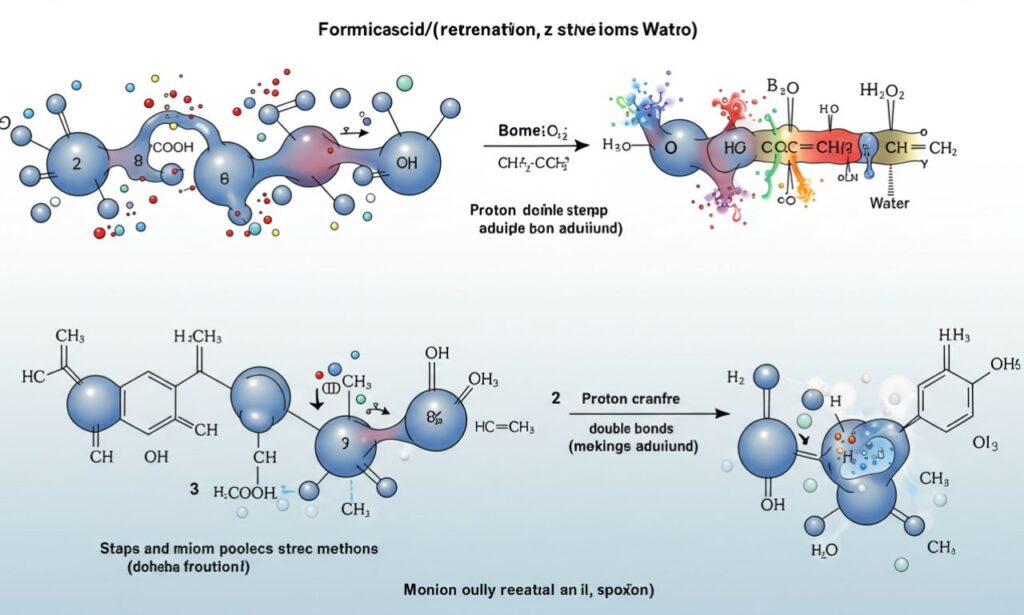Chemical reactions are like tiny stories written in molecular language, and one such fascinating tale is the reaction involving hcooch ch2 h2o. Known in chemical terms as the reaction between formic acid (HCOOH), methylene (CH₂), and water (H₂O), this process offers a unique glimpse into organic transformations, especially when discussing reactive intermediates and hydration processes.
Chemists often come across combinations like hcooch ch2h2o while studying basic organic reaction mechanisms or during lab experiments involving carboxylic acids and related compounds. This reaction is intriguing because it showcases simple molecular interactions leading to a more complex and functional molecule.
What Is hcooch ch2 h2o?
The notation “hcooch ch2h2o” represents the interaction of formic acid (HCOOH) with methylene (CH₂) and water (H₂O). At first glance, it may seem ambiguous. But in organic chemistry, this notation is often used in reaction schemes to represent a hydration or decomposition reaction, possibly leading to alcohols or intermediates like formaldehyde or methanol depending on the reaction conditions.
Let’s break down the possible interpretation:
-
HCOOH – Formic acid, the simplest carboxylic acid.
-
CH₂ – Methylene, a highly reactive carbene species.
-
H₂O – Water, a universal solvent and nucleophile.
When these react, especially under heat or in the presence of catalysts, they can form various products such as hydroxymethyl formate (HCOOCH₂OH), methanol, or even CO₂ and H₂ under decomposition conditions.
Breaking Down the hcooch ch2 h2o Reaction Mechanism
Understanding the underlying reaction mechanism involves interpreting each molecule’s role:
-
Formic acid acts as a carboxylic acid source.
-
CH₂ may be generated in situ or could be a simplified representation of a reactive intermediate.
-
Water assists in hydrolysis or adds across double bonds if present.
The most common reaction seen in such scenarios is hydration, where water is added to an organic intermediate, or hydrolysis, where water breaks a bond. In this case, the reaction may result in the formation of methanol (CH₃OH) and carbon dioxide (CO₂) if decomposed thermally.
Chemical Equation Representation of hcooch ch2h2o
A plausible reaction equation could be:
This represents either the formation of hydroxymethyl formate or decomposition into methanol and carbon dioxide. The pathway depends on the temperature, catalysts, and presence of acids or bases.
Significance of hcooch ch2 h2o in Organic Chemistry
Reactions involving formic acid and methylene serve as foundational studies in organic chemistry. Here’s why it matters:
-
Teaches reaction pathways such as nucleophilic additions and hydrolysis.
-
Demonstrates thermal decomposition, a process used in formic acid breakdown.
-
Supports fuel cell research, since formic acid can be a hydrogen donor.
Moreover, hcooch ch2h2o is useful in lab synthesis, particularly in functional group transformations and small molecule research.
How Does Temperature Affect the hcooch ch2 h2o Reaction?
Temperature plays a crucial role:
-
Low temperatures promote hydration and stability of intermediates like hydroxymethyl formate.
-
High temperatures lead to decomposition, often releasing CO₂ and hydrogen gas (H₂), which can be used in fuel cells or clean energy processes.
Controlling temperature allows chemists to direct the reaction toward desired products.
Catalysts Used in hcooch ch2 h2o Reactions
Catalysts can drastically influence the outcome. Typical catalysts include:
-
Acid catalysts (e.g., H₂SO₄ or HCl) enhance hydrolysis.
-
Base catalysts (e.g., NaOH) encourage decomposition.
-
Metal catalysts (e.g., Pd or Pt) assist in hydrogen release.
Choice of catalyst decides whether the outcome is a stable ester, alcohol, or gas mixture.
Potential Applications of hcooch ch2 h2o
This chemical system is more than just textbook theory:
-
Fuel cell technology – Especially direct formic acid fuel cells (DFAFCs).
-
Organic synthesis – Used for creating esters, alcohols, and aldehydes.
-
Green chemistry – Offers eco-friendly hydrogen production.
Its applications are expanding into pharmaceuticals, plastics, and sustainable energy.
Safety Considerations with hcooch ch2 h2o
Handling these chemicals requires caution:
-
Formic acid is corrosive and can cause burns.
-
Methylene (if in carbene form) is highly reactive and dangerous.
-
Always wear protective gear and operate under a fume hood.
Proper waste disposal is also essential due to potential environmental hazards.
Industrial Use of hcooch ch2h2o Systems
Industries exploit these reactions for:
-
Hydrogen generation
-
Intermediate synthesis for resins
-
Fine chemical production
They offer a balance of efficiency and eco-friendliness, especially with sustainable energy goals.
Lab Experiment: Observing hcooch ch2h2o Reaction
In a typical undergraduate organic lab:
-
Formic acid and an equivalent methylene precursor are mixed in water.
-
Reaction is heated mildly or catalyzed.
-
Product analysis is done via TLC or NMR.
Such labs teach hands-on experience in reaction monitoring and product identification.
Environmental Impact of hcooch ch2h2o Chemistry
Using formic acid as a hydrogen source reduces reliance on fossil fuels. When decomposed, the only by-products are:
-
Carbon dioxide (recyclable)
-
Water
-
Hydrogen (clean fuel)
This makes it an environmentally sound alternative for certain energy applications.
Why hcooch ch2h2o Deserves More Attention
Despite being simple, this reaction holds:
-
Scientific interest
-
Practical applications
-
Environmental promise
Its versatility in lab and industry makes it a key player in modern chemistry.
Conclusion
The hcooch ch2h2o reaction may appear deceptively simple, but its implications stretch across energy science, green chemistry, and organic synthesis. Whether used in a lab experiment or scaled in industrial hydrogen production, the chemistry of formic acid, methylene, and water continues to intrigue and inspire. It embodies the core of chemistry—transforming basic substances into something more valuable.






